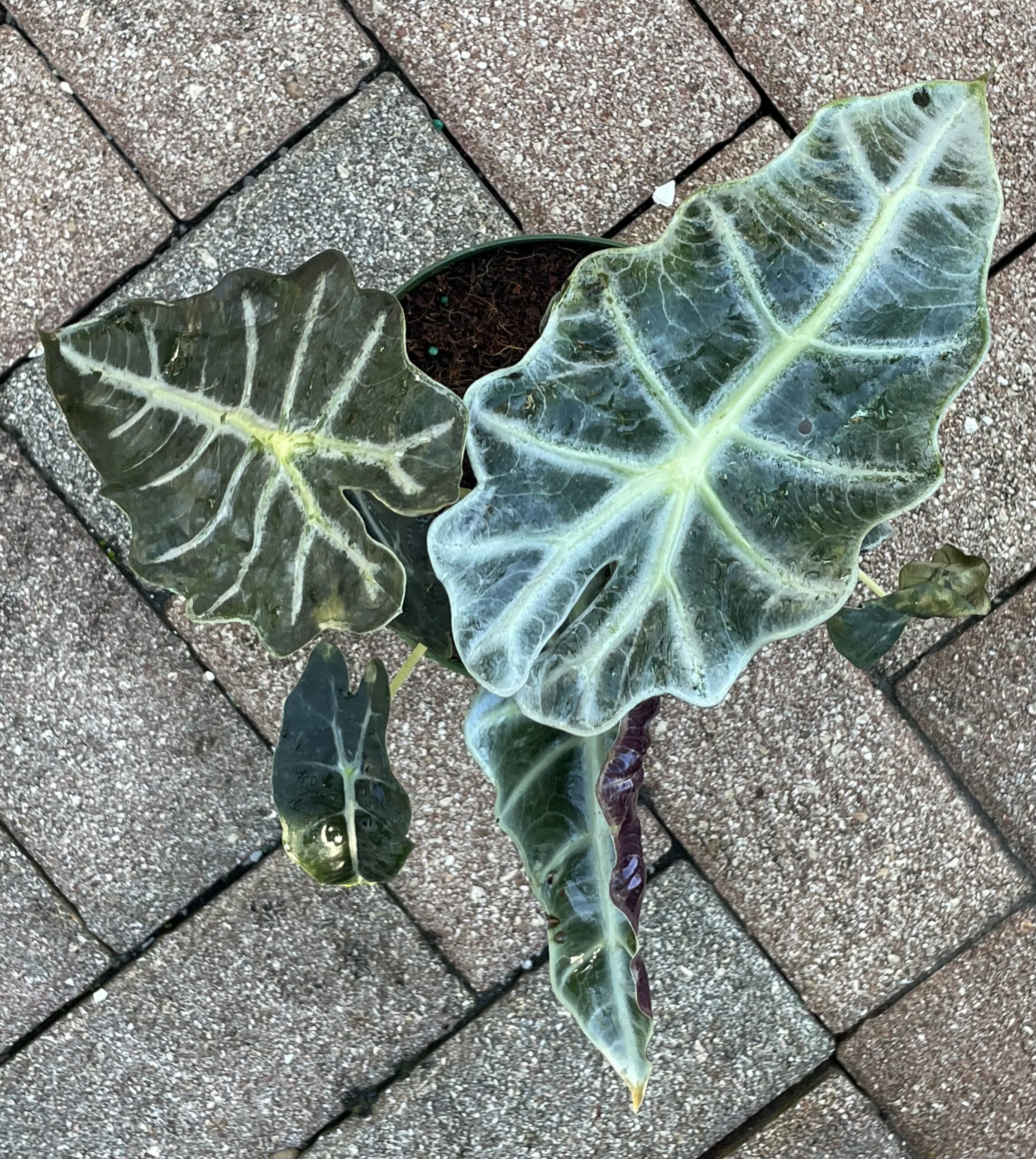
ALLURING ALOCASIAS
Commanding a distinctive and robust presence in any garden, the large, arrow-shaped bouquet of leaves known as the Giant Upright Elephant Ear or botanically speaking the Alocasia macrorrhiza – macro meaning large and rrhiza referring to its style of growth by large underground rhizomes or roots. Growing in front of the Edison home, the plant sports upright leaves on stiff stems, which is an identification clue to its inclusion in the genus of Alocasia.
Easily confused with the Giant Elephant Ear known as Giant Calocasia, one can recognize the difference in that calocasia leaves hang down. There are quite a few more distinctions but let us save that for later.
Certainly, a plant this size is not for everyone, so let us explore some other alocasias in the genus that are frequently available in our Garden Shoppe, sometimes overlooked because they are protected in an area specifically for shady plants.
Part of the Arecaceae or Arum family, alocasias have many cousins including caladiums, calla lilies, monsteras, dieffenbachias and peace lilies. This makes sense, as they each possess a common and unusual flowering technique: Tiny flowers are clustered on a stem called a spadix and as a unit, they are protected and surrounded by a spathe or hood. While these flowers are quite noticeable on calla lilies for instance, they are rarely visible on alocasias. If you are fortunate to have an alocasia bloom for you, the reward will be a pleasantly fragrant experience.
THERE ARE MANY ALOCASIAS GROWING IN THE GARDENS AT EDISON AND FORD WINTER ESTATES. THESE LARGE-LEAVED PLANTS ADD A TROPICAL FEEL TO A FLORIDA GARDEN.

The genus of Alocasias has over 100 species, all originating from tropical Asia and Australia, whereas the genus of Calocasia mentioned above, has only 12 species from Asia and India. Calocasia roots are often grown and prepared as a highly nutritious and starchy food staple in large parts of the world, whereas all parts of alocasias are considered toxic and should never be ingested by humans or domestic pets. As shown in the names of some of the alocasias showcased in this article, these plants are often hybridized to maximize preferred characteristics such as size, color variegation or patterns.
As a houseplant, alocasias are an exceptional addition to a collection, because they are relatively easy to maintain, often sporting a waxy or glossy leaf, and they don’t want any direct sunlight. They prefer only to be watered once the top 2 to 3 inches of soil has dried out and they are frequently the perfect candidate for a self-watering pot. Because they enjoy consistent temperatures between 65 to 85 degrees and high humidity, it is possible they may retreat in vigor over the harshest winter months, spending a little time in a somewhat dormant stage if their environmental temperatures go below 60 degrees and humidity is low. Should this happen, remove any spent or yellowed leaves, and allow your alocasia to rest by withholding water until the top 3 inches of soil is dry, and do not use any fertilizer. Keep it out of sunlight and maintain its temperature, which is easy as it is within the range we humans generally prefer. Once higher temperatures and humidity levels resume, that large rhizomatous root will start to send up new shoots and by summer, the plant should look fabulous again. When the first new leaf appears, it is time to start applying a biweekly, diluted liquid and organic fertilizer. We recommend avoiding using granular, slow-release or other chemical fertilizers to avoid the possibility of salt buildup around the plant.
*As a houseplant, alocasias are an exceptional addition to a collection, because they are relatively easy to maintain, often sporting a waxy or glossy leaf, and they don’t want any direct sunlight.
Alocasias do not mind being slightly pot- bound, but if roots start to sneak out of the pot’s drainage holes it is time to repot but keep the upsizing to only an additional inch or two. Repotting will only be necessary every other year. Doing so will avoid having the plant in a pot so full of soil that if overwatered, will result in the plant becoming waterlogged. Soil should be a crumbly, quickly draining mixture.
Which alocasia is best? An 8-foot-tall specimen recently spotted at the January Tropical Plant International Exhibition, the 22 Gateway Lifestyle Alocasia sulawesi “Jacklyn” is sometimes available in the Garden Shoppe at Edison and Ford Winter Estates and its two-toned, textured leaves give it a kind of prehistoric big, bold, and beautiful look and will not be mistaken for any other kind of plant! This is a great candidate for a self-watering pot and sure to be a conversation starter.
Looking for something a bit smaller? “Polly” or “African Mask” (Alocasia x amazonica ‘Polly) is frequently available in the Garden Shoppe due to its popularity for growing only to about 2 feet in height. Those uprising leaves are wavy edged and have distinctive white veins. It does well indoors or outdoors if the previously discussed conditions are provided.
Even more demure, Alocasia “Tiny Dancer,” (Alocasia brisbanensis x Alocasia odora ‘Tiny Dancer’) swirling upward to about 20 inches, looks best in a grouping, as its plain dark green waxy leaves pirouette in their pot. Of course, I placed a planter of this deep in the shady end of the Moonlight Garden at the Estates.
Another statement alocasia, Alocasia “Regal Shield” (Alocasia odora x Alocasia reginula ‘Regal Shield’) is a medium-large variety, topping out at around 5 feet. Best enjoyed in a bright light environment, it may be elevated on a garden stand to best appreciate the dark green glossy foliage of Regal Shield with its rich, dark purple underside protruding from lime-green stems
Alocasia “Portadora” will present with ruffled, 8-foot-tall leaves and loves being outside, providing it is grown in fast-draining soil to avoid waterlogged roots. It will also do well in a large pot, and like all alocasias, if grown indoors, the large face area of the huge leaves serves as a natural air filter in the home.
For the gardener that likes variegated leaves, Alocasia macrorrhiza, var. “Lutea” or “Variegata” are both large species, the former, a green and gold variety, growing in front of Edison’s home and the latter, tucked into a shady spot in the Moonlight Garden, where the variegated green and white leaves will hopefully reach their mature height of 15 feet.
*If you are fortunate to have an alocasia bloom for you, the reward will be a pleasantly fragrant experience.
These foliage plants add architectural interest to just about any type of garden. The selection and availability changes frequently in the Garden Shoppe, so visit often and look around for a rare beauty. Feel free to reach out to a member of the horticulture team if you have questions about a plant’s care.






